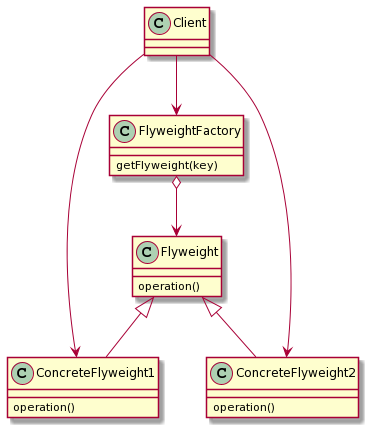Jeśli moja strona Ci pomogła, i chcesz aby była bardziej rozwijana, wesprzyj mnie buy me a coffee
|
I. Wzorce kreacyjne 1. Singleton 2. Budowniczy 3. Prototyp 4. Fabryka 5. Fabryka abstrakcyjna II. Wzorce strukturalne 1. Adapter 2. Most 3. Kompozyt 4. Dekorator 5. Fasada 6. Pyłek 7. Pełnomocnik III. Wzorce czynnościowe 1. Łańcuch zobowiązań 2. Polecenie 3. Interpreter 4. Iterator 5. Mediator 6. Pamiątka 7. Obserwator 8. Stan 9. Strategia 10. Metoda szablonowa 11. Odwiedzający |
Pyłek - waga piórkowa (flyweight) - wzorzec projektowy - java1. Cel:Wzorzec Pyłek - waga piórkowa (flyweight) minimalizuje użycie pamięci przez udostępnianie danych obiektom o podobnym typie. Wzorzec służący do optymalizacji, bardziej wydajne użyci pamięci, przez podobne obiekty (immutable). Zapewniają dużą wydajność i ulepszone przetwarzanie w przypadku dużej liczby podobnych obiektów. Wzorzec wykorzystuje współdzielenie identycznego komponentu obiektu. Jest to wzorzec wzorców, używa m.in. wzorzec Fabryki (Factory). 2. Problem: Chcemy aby obiekty tego samego typu były tworzone tylko raz. Np. mamy pozycję w sklepie internetowym, i pozycji tego samego typu tworzonych jest mnóstwo, nie chcemy za każdym razem każdą pozycję tworzyć od nowa. 3. Rozwiązanie: Tworzymy obiekt tylko jeden raz, przy jego wywołaniu sprawdzamy czy go wcześniej nie zcacheowaliśmy. Jeżeli jest scachowany bierzemy już wcześniej stworzony obiekt i zwracamy go wzorcem fabryki. 4. Diagram klas wzorca Pyłek - waga piórkowa (flyweight):  5. Implementacja: Pozycja w naszym sklepie:
- java.lang.Integer#valueOf(int) (również String, Boolean, Byte, Character, Short, Long and BigDecimal) |
|---|